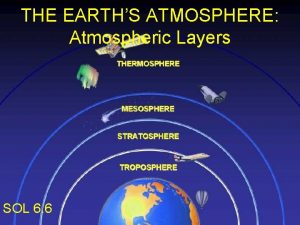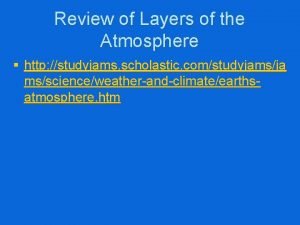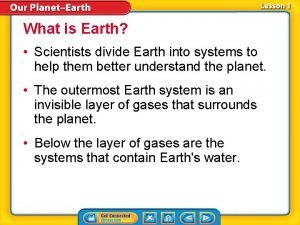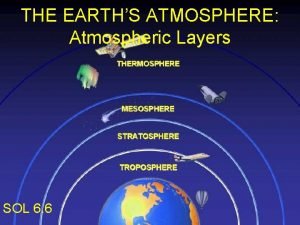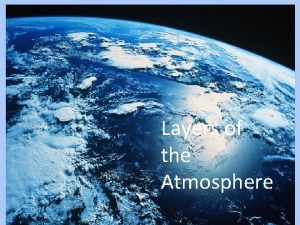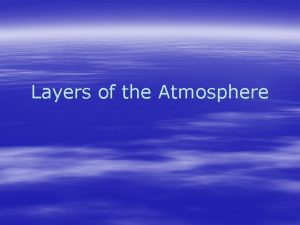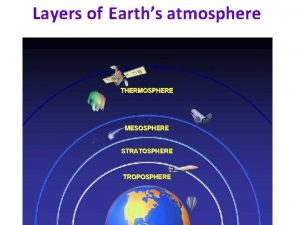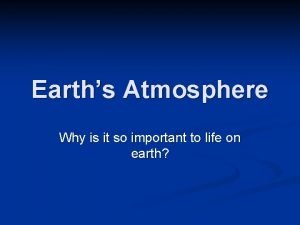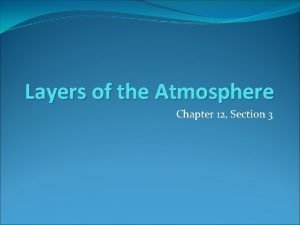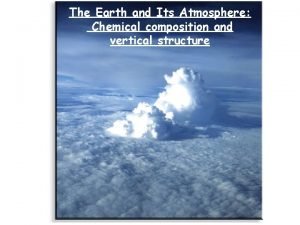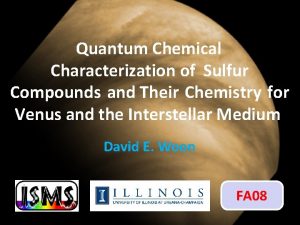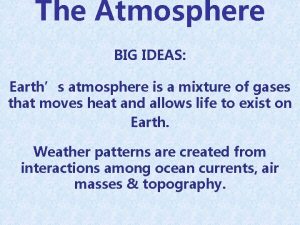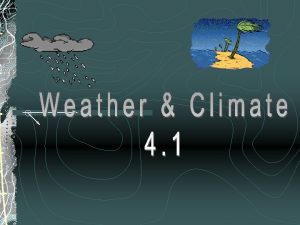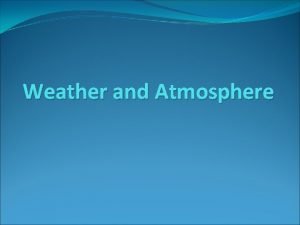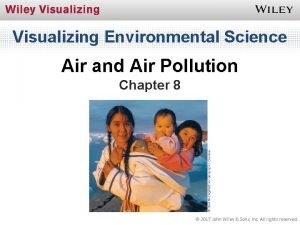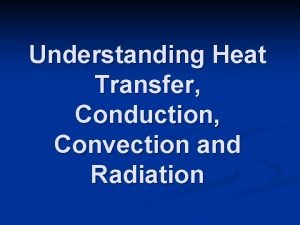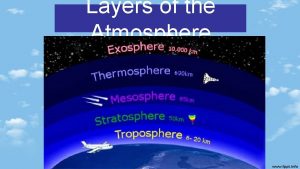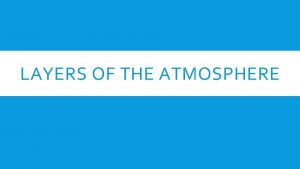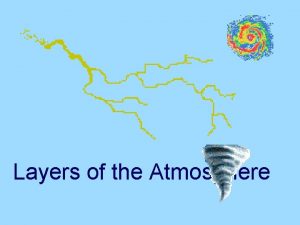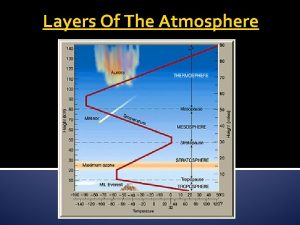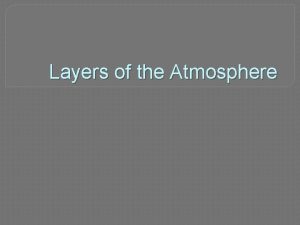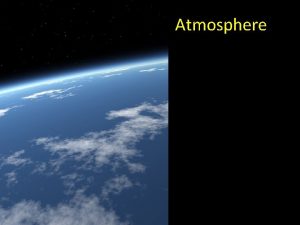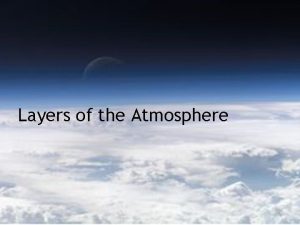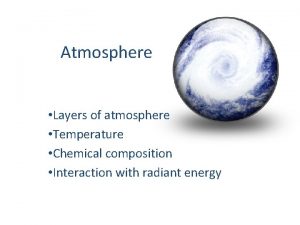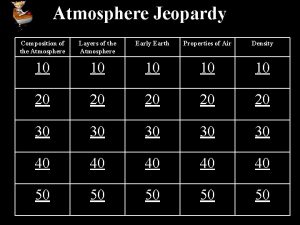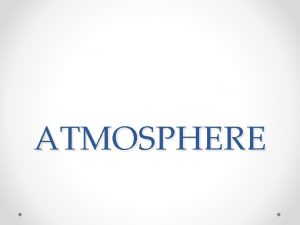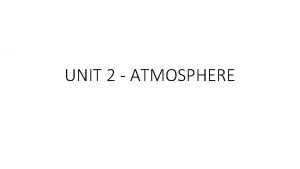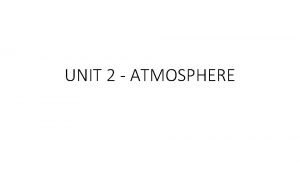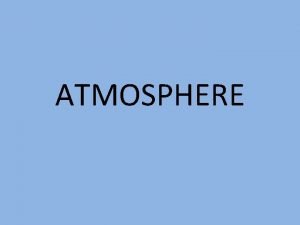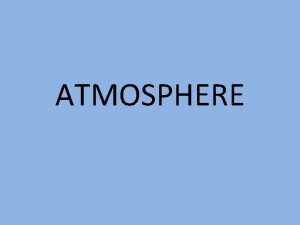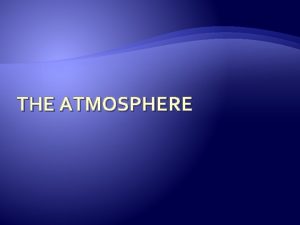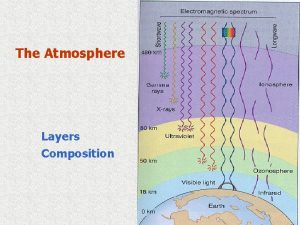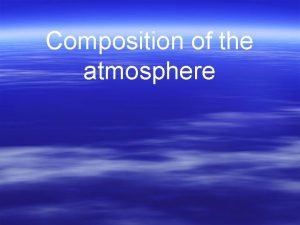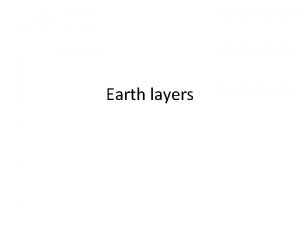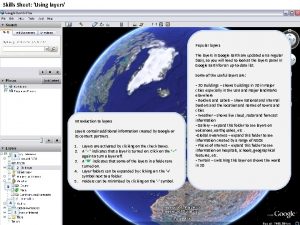22 1 Introduction to the Atmosphere Layers composition


























































- Slides: 58

22. 1 Introduction to the Atmosphere (Layers & composition) By Unknown Author & Bill Holmes, U. of Michigan Modified by Laura Smith

Thin Blue Line Click on picture or title

The Atmosphere § The layers of gas surrounding the Earth § Mixture of chemicals (elements and compounds) called AIR § § § Protects Earth from solar radiation Helps regulate temperature on the planet Divided into layers based on temperature changes with increasing altitude

Composition of the Atmosphere

Composition of the Atmosphere Argon,


Which Gas Makes Up More of Our Atmosphere: Nitrogen or Oxygen? This question will try to trick you in the future!

NITROGEN § Nitrogen makes up about 78% of Earth’s atmosphere and is maintained through the nitrogen cycle.

NITROGEN § Nitrogen is removed from the air mainly by the action of nitrogen-fixing bacteria. § Decay releases nitrogen back into the atmosphere.

OXYGEN § Oxygen makes up about 21% of Earth’s atmosphere. § Land ocean plants produce large quantities of oxygen in a process called photosynthesis. Stromatolites Cyanobacteria

OXYGEN § Bacteria and plants add oxygen from the air as part of their life processes. § Animals remove oxygen from the air.

WATER VAPOR § As water evaporates from oceans, lakes, streams, and soil, it enters air as the invisible gas water vapor. § Plants give off water vapor during transpiration; animals during respiration.

WATER VAPOR As water vapor enters the atmosphere, it is removed by the processes of condensation and precipitation in the hydrologic, or water cycle.

WATER VAPOR § The humidity is a measure of the water vapor in the air. § The percentage of water vapor in the atmosphere varies depends on factors such as time of day, location, and season.

WATER VAPOR § Relative humidity changes with temperature.

OZONE Ozone is a gas molecule that is made up of three oxygen atoms § Ozone in the upper stratosphere forms the ozone layer, which absorbs harmful ultraviolet radiation from the sun.

OZONE § Ozone in the upper stratosphere forms the ozone layer, which absorbs much of the harmful ultraviolet radiation from the sun.

OZONE § Without the ozone layer, living organisms would be severely damaged by the sun’s ultraviolet rays.

OZONE § Unfortunately, a number of human activities damage the ozone layer. § Chloro. Fluoro. Carbons (CFCs) (originally used in aerosols & refrigerants & styrofoam manufacturing) break apart ozone molecules creating a “hole” in the ozone layer

Good Ozone, Bad Ozone Too little there. . . CFC’s and halons from air conditioners and refrigerators break down the protective ozone layer. Too much here. . . Vehicles, power plants and factories emit air pollution that forms ground-level ozone.

Sources of Ground-Level Ozone NOx, VOC + sunlight Ozone

OZONE HOLE § NASA Exploring Ozone Click title for 2: 20 min video

OZONE HOLE § OZONE HOLE 1979 -2007 MOVIE

OZONE HOLE § Ozone Movie

PARTICULATES § Many natural and manmade particulates are in the atmosphere § Dust, pollen, volcanic eruptions and sea spray all add natural, tiny solid particles to the atmosphere.

Primary Pollutants § Man-made particulates = pollution

Atmospheric Pressure the force per unit area that is exerted on a surface by the weight of the atmosphere

Atmospheric Pressure § Gravity holds the gases of the atmosphere near Earth’s surface. § As a result, the air molecules are compressed together and exert force on Earth’s surface.

Atmospheric Pressure is measured with a barometer.

Atmospheric Pressure

Atmospheric Pressure § Atmospheric pressure is exerted equally in all directions—up, down, and sideways-- and results from collision of gas particles.

Atmospheric Pressure At higher altitudes, or elevations, air molecules are farther apart and exert less pressure on each other (and you).

Layers of the Atmosphere Troposphere: (“change”) § Lowest layer (0 -18 km = 0 -10 miles) § Warmest layer; decreases going up (20° at bottom to -60° at top) § Weather occurs here; clouds form at top § Water vapor & CO 2 § All Life § Hot Air Balloons, airplanes, birds § Densest & smallest layer

Layers of the Atmosphere Stratosphere: (“Layer”) § Second layer (18 -50 km = 28 -31 miles) § Ozone layer (@20 -30 km) blocks UV rays § Temp. goes up as you go up (-60° bottom to 0° at top) § Windy & Dry § Weather balloons § Some jet planes and clouds at bottom

Layers of the Atmosphere Mesosphere: (“middle”) § Third layer (50 - 80 km= 53 -62 miles) § Meteors burn up § Coldest layer (0° at bottom to -80°C at top)

Layers of the Atmosphere Ionosphere: § At Mesopause & in both Meso- & Thermospheres § 96 -112+ km § Solar energy removes electrons § Four layers of ions and electrons § Causes Aurora Borealis&Australis § Bounces radio waves (esp. AM) Outer Space (‘Exosphere’) IONOSPHERE

Layers of the Atmosphere Thermosphere: (“Heat”) § Highest layer (80 ~ 500 km = 82~373 mi) § K. E. of particles equal to 2000°C! § Aurorae § Satellites and Space Stations Outer Space (‘Exosphere’)

Layers of the Atmosphere “PAUSES” § Breaks between layers § Delineated by changes in temperature direction (starts rising or falling here) § All layers and pause heights vary based on latitude and season THERMOPAUSE MESOPAUSE STRATOPAUSE TROPOPAUSE

Layers of the Atmosphere Exosphere: (“EXIT”) § Highest layer (Above ~ 500 km) § Some consider this outside the atmosphere § Blends with the complete vacuum of space (No limit) § Temperature drops again Outer Space (‘Exosphere’)

How the Temperature Changes in the Layers § Temperature trends alternate from layer to layer § These shifts are the boundaries between layers § Memorize these!

Silly way to remember the order of the layers § E xtra § T errestrials § M ay § S wim § Tonight

Temperature Inversions § § § Warm air rises Cold air sinks Cool air during the winter, or from ocean influences, gets trapped beneath warmer air passing over mountains = temperature inversions

Temperature Inversions Denver, CO Salt Lake City, UT Los Angeles, CA

What Was the Early Atmosphere Like? § 4. 4 billion years ago: – Formed by volcanic eruptions and meteorite impacts – Mostly carbon dioxide, water vapor, and some nitrogen – No known life A bright Geminid meteor pierces the night sky over California's Mojave Desert in 2009. http: //news. nationalgeographic. com/news/2011/09/110907 gold-metals-earth-meteors-oldest-rocks-nature-science/

Plants Changed the Atmosphere § Tiny marine plants (cyanobacteria, phytoplankton, and algae) appear: – Photosynthesize carbon dioxide to oxygen – Over millions of years: carbon dioxide falls and oxygen rises

Evidence? 1. Fossils - Plants need carbon dioxide and animals need oxygen - Earliest fossils = plants only (so there was carbon dioxide)

Animal fossils later appear in rocks (so oxygen was in the air at that time)

More evidence 2. Glacial Ice Cores - Some glaciers (frozen rivers of ice) have existed for millions of years. - When the glacier freezes, it traps bubbles of the current atmosphere.

We can sample the glaciers (ice cores) and measure the abundance of gases trapped inside.

§ Ice cores show us that: Oldest ice contains no oxygen, but plenty of carbon dioxide and nitrogen As ice gets younger, the carbon dioxide falls and oxygen rises

Is Earth’s Atmosphere Unique? Yes, and thank goodness! § It has huge amounts of water vapor § The temperature is just right § Contains huge amounts of oxygen

Extra Terrestrial Atmospheres § They’re out of this world!!!! http: //www. grida. no/publications/vg/climate/page/3056. aspx

Let’s look at our neighbors:

The Atmosphere on Mars § Thin, dusty § Low pressure § 95% carbon dioxide, 3% nitrogen, 1. 6% argon, and only traces of oxygen, water, and methane § Carbon dioxide icecaps at the poles

And now, Earth’s Twin…. .

The Atmosphere on Venus § Thick, dry § Almost entirely carbon dioxide and nitrogen § Thick clouds of sulfur dioxide that rain acid § GREENHOUSE EFFECT (460º C)

Could Venus foretell our future? § Scientists think that the hostile environment on Venus used to be more like Earth § There may have been lots of liquid water on Venus’s surface § The water was evaporated away by the greenhouse effect

It’s all we have! Protect it!
 Layers of the atmosphere song
Layers of the atmosphere song Study jams heat
Study jams heat Scientists divide the atmosphere into how many layers?
Scientists divide the atmosphere into how many layers? Atmosphere definition
Atmosphere definition Layers of the atmosphere song
Layers of the atmosphere song What are the layers of the atmosphere
What are the layers of the atmosphere First layer of atmosphere
First layer of atmosphere Layers of the atmosphere
Layers of the atmosphere Atmosphere levels
Atmosphere levels Section 1 atmospheric basics continued answers
Section 1 atmospheric basics continued answers Structure of atmosphere
Structure of atmosphere Hsocl
Hsocl Explain composition and structure of atmosphere
Explain composition and structure of atmosphere Hát kết hợp bộ gõ cơ thể
Hát kết hợp bộ gõ cơ thể Lp html
Lp html Bổ thể
Bổ thể Tỉ lệ cơ thể trẻ em
Tỉ lệ cơ thể trẻ em Voi kéo gỗ như thế nào
Voi kéo gỗ như thế nào Glasgow thang điểm
Glasgow thang điểm Hát lên người ơi alleluia
Hát lên người ơi alleluia Các môn thể thao bắt đầu bằng tiếng nhảy
Các môn thể thao bắt đầu bằng tiếng nhảy Thế nào là hệ số cao nhất
Thế nào là hệ số cao nhất Các châu lục và đại dương trên thế giới
Các châu lục và đại dương trên thế giới Công thức tiính động năng
Công thức tiính động năng Trời xanh đây là của chúng ta thể thơ
Trời xanh đây là của chúng ta thể thơ Cách giải mật thư tọa độ
Cách giải mật thư tọa độ Làm thế nào để 102-1=99
Làm thế nào để 102-1=99 Phản ứng thế ankan
Phản ứng thế ankan Các châu lục và đại dương trên thế giới
Các châu lục và đại dương trên thế giới Thơ thất ngôn tứ tuyệt đường luật
Thơ thất ngôn tứ tuyệt đường luật Quá trình desamine hóa có thể tạo ra
Quá trình desamine hóa có thể tạo ra Một số thể thơ truyền thống
Một số thể thơ truyền thống Cái miệng xinh xinh thế chỉ nói điều hay thôi
Cái miệng xinh xinh thế chỉ nói điều hay thôi Vẽ hình chiếu vuông góc của vật thể sau
Vẽ hình chiếu vuông góc của vật thể sau Thế nào là sự mỏi cơ
Thế nào là sự mỏi cơ đặc điểm cơ thể của người tối cổ
đặc điểm cơ thể của người tối cổ V cc
V cc Vẽ hình chiếu đứng bằng cạnh của vật thể
Vẽ hình chiếu đứng bằng cạnh của vật thể Phối cảnh
Phối cảnh Thẻ vin
Thẻ vin đại từ thay thế
đại từ thay thế điện thế nghỉ
điện thế nghỉ Tư thế ngồi viết
Tư thế ngồi viết Diễn thế sinh thái là
Diễn thế sinh thái là Các loại đột biến cấu trúc nhiễm sắc thể
Các loại đột biến cấu trúc nhiễm sắc thể Bảng số nguyên tố
Bảng số nguyên tố Tư thế ngồi viết
Tư thế ngồi viết Lời thề hippocrates
Lời thề hippocrates Thiếu nhi thế giới liên hoan
Thiếu nhi thế giới liên hoan ưu thế lai là gì
ưu thế lai là gì Hổ đẻ mỗi lứa mấy con
Hổ đẻ mỗi lứa mấy con Sự nuôi và dạy con của hươu
Sự nuôi và dạy con của hươu Hệ hô hấp
Hệ hô hấp Từ ngữ thể hiện lòng nhân hậu
Từ ngữ thể hiện lòng nhân hậu Thế nào là mạng điện lắp đặt kiểu nổi
Thế nào là mạng điện lắp đặt kiểu nổi Temporary behavior of atmosphere
Temporary behavior of atmosphere Hottest layer of atmosphere
Hottest layer of atmosphere The atmosphere protects earth from
The atmosphere protects earth from Hottest layer of atmosphere
Hottest layer of atmosphere
